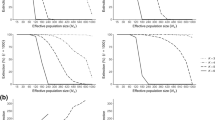Abstract
We demonstrate the effect of fish predation on genotype frequencies in a laboratory population composed of two Daphnia magna clones, with historically contrasting exposures to fish predation. The two clones differed in their responsiveness to predation via differential avoidance/escape behavior. The clone which coexists with fish in nature is more responsive to the presence of a fish predator, while the clone not exposed to fish predation does not exhibit the defensive reaction. Fish caused a rapid (within 18 h) and significant shift in Daphnia clonal composition, from 1:1 to 8:1, in favor of the responsive clone. Genotype-specific defensive abilities (modus defendi) can contribute greatly to the phenomenon of genotype replacement under selective predation.
Similar content being viewed by others
References
Dawidowicz P (1993) Diel vertical migration in Chaoborus flavicans: population patterns vs individual tracks. Arch Hydrobiol Beih Erg 39:19–28
Dawidowicz P, Pijanowska J, Ciechomski K (1990) Vertical migration of Chaoborus larvae is induced by the presence of fish. Limnol Oceanogr 35:1631–1637
Dickman CR (1992) Predation and habitat shift in the house mouse, Mus domesticus. Ecology 73:313–322
Elton CS (1927) Animal ecology. Sedgewick & Jackson, London
Endler JA (1986) Natural selection in the wild. Princeton University Press, Princeton
Gliwicz ZM (1986) Predation and the evolution of vertical migration behaviour in zooplankton. Nature 320:746–748
Fawcett MH (1984) Local and latitudinal variation in predation on an herbivorous marine snail. Ecology 65:1214–1230
Janzen DH (1981) Evolutionary ecology of personal defence. In: Townsend CR, Calow P (eds) Physiological ecology: an evolutionary approach to resource use. Sinauer, pp 145–164
Hebert PDN, Beaton MJ (1989) Methodologies for allozyme electrophoresis using cellulose acetate electrophoresis: a practical handbook. Helena Laboratories, Beaumont
Lampert W (1989) The adaptive significance of diel vertical migration of zooplankton. Funct Ecol 3:21–27
Lampert W (1992) Ultimate causes of diel vertical migration of zooplankton: new evidence for the predator avoidance hypothesis. Arch Hydrobiol Beih Erg 39:79–88
Lima SL, Dill LM (1990) Behavioral decisions made under the risk of predation: a review and prospectus. Can J Zool 68:619–640
Loose CJ, Elert E von, Dawidowicz P (1992) Chemically-induced diel vertical migration in Daphnia: a new bioassay for kairomones exuded by fish. Arch Hydrobiol 126:329–337
Manly BFJ (1974) A model for certain types of selection experiments. Biometrics 30:281–294
Meester L de (1990) Evidence for intra-population genetic variability for phototactic behavior in Daphnia magna Straus., 1820. Biol Jaarb Dodonaea 58:84–93
Parejko K, Dodson SI (1991) The evolutionary ecology of an antipredator reaction norm: Daphnia pulex and Chaoborus americanus. Evolution 45:1665–1674
Pijanowska J (1993) Diel vertical migration in zooplankton: fixed or inducible behavior? Arch Hydrobiol Beih Erg 39:89–97
Sih A (1987) Predators and prey lifestyles: an evolutionary and ecological overview. In: Kerfoot WC, Sih A (eds) Predation: direct and indirect impacts on aquatic communities, University Press of New England, pp 203–224
Spitze K (1991) Chaoborus predation and life-history evolution in Daphnia pulex: temporal pattern of population diversity, fitness and mean life history. Evolution 45:82–92
Weider LW (1984) Spatial heterogeneity of Daphnia genotypes: Vertical migration and habitat partitioning. Limnol Oceanogr 29:225–235
Weider LW (1985) Spatial and temporal genetic heterogeneity in a natural Daphnia population. J Plankt Res 7:101–123
Author information
Authors and Affiliations
Rights and permissions
About this article
Cite this article
Pijanowska, J., Weider, L.J. & Lampert, W. Predator-mediated genotypic shifts in a prey population: experimental evidence. Oecologia 96, 40–42 (1993). https://doi.org/10.1007/BF00318028
Received:
Accepted:
Issue Date:
DOI: https://doi.org/10.1007/BF00318028




